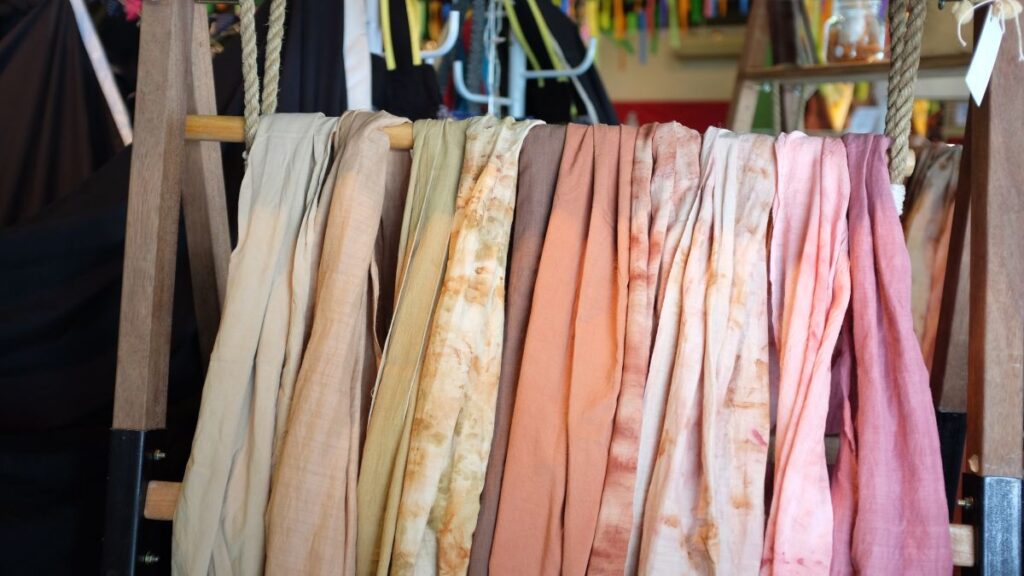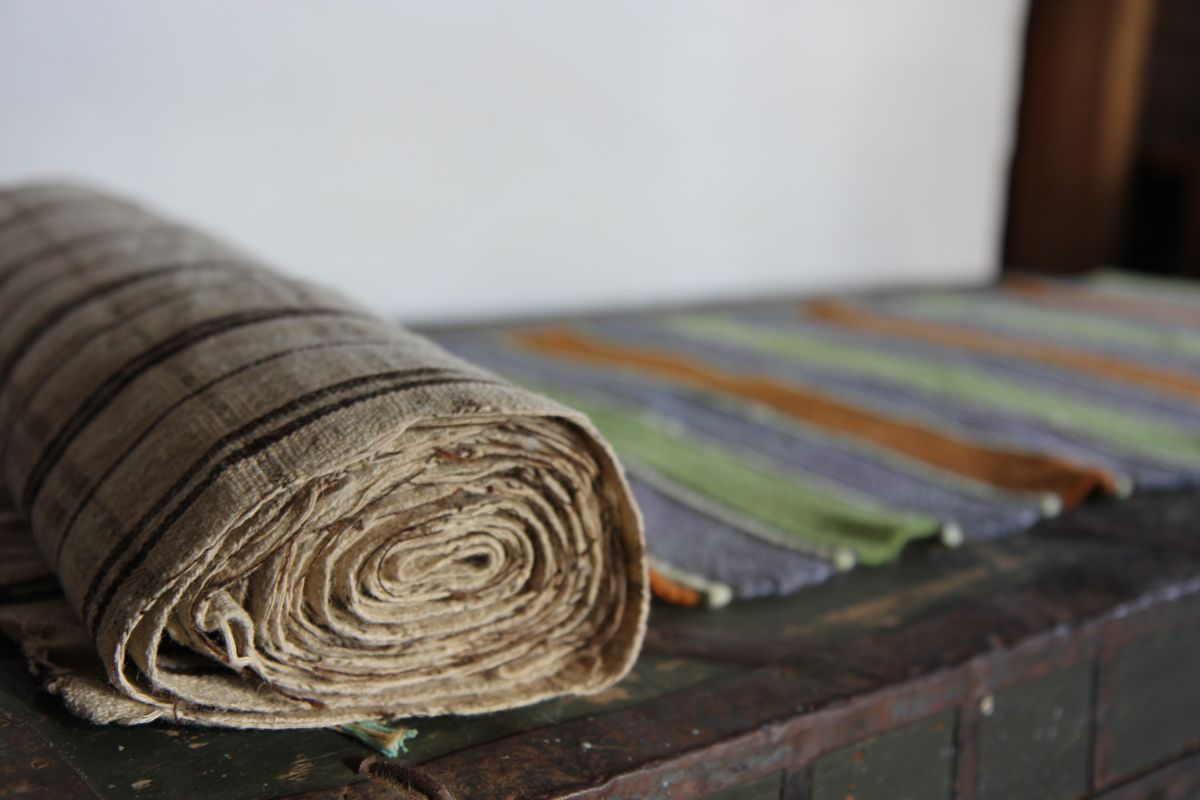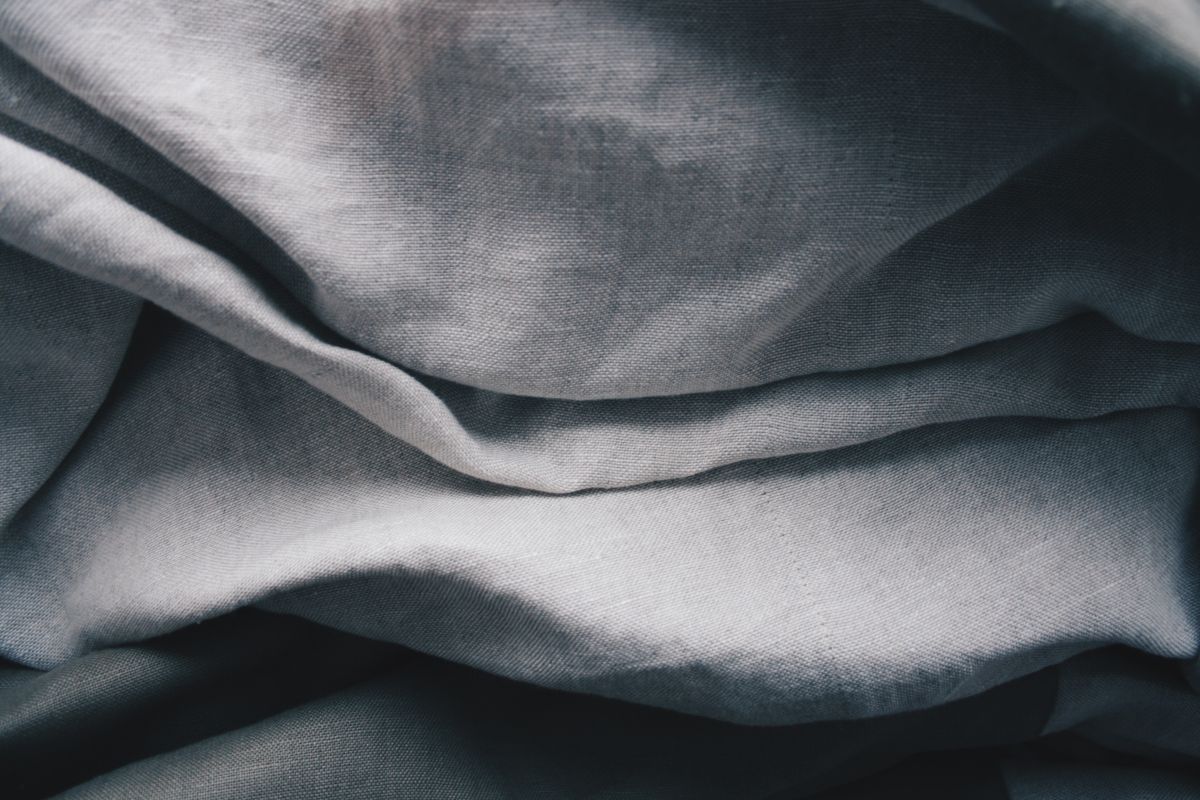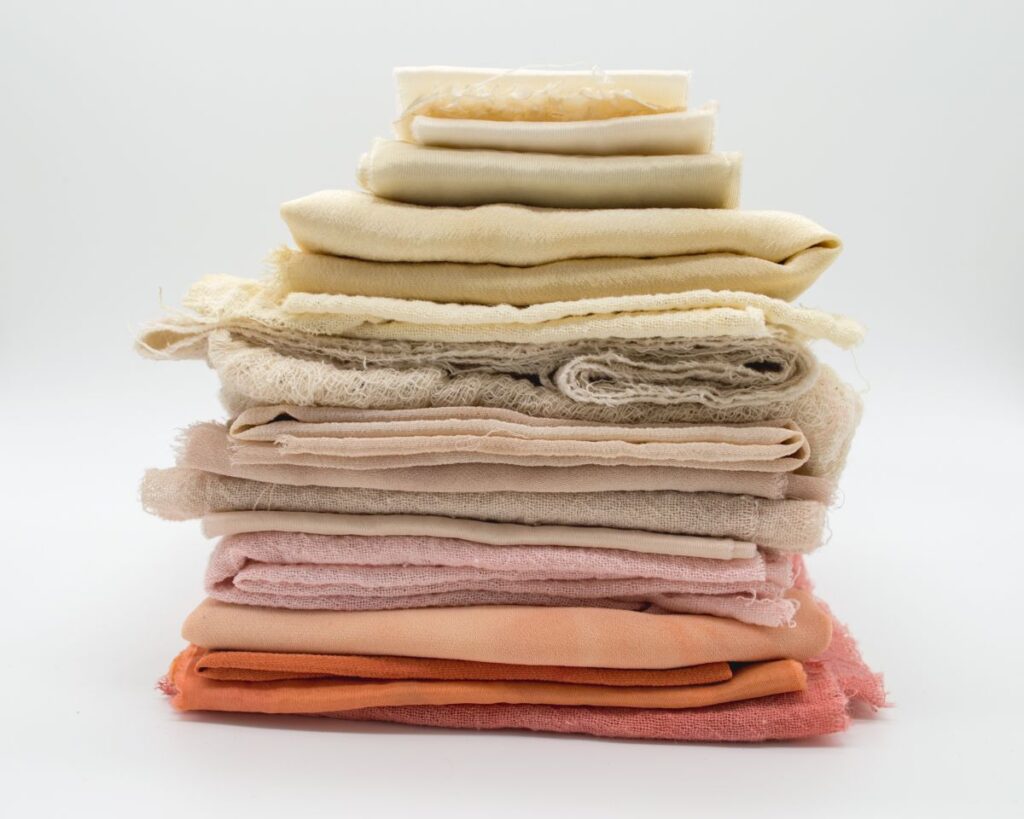Natural plant fibre textiles are environmentally preferable, therefore opting for those while purchasing clothing. The clothing is lightweight, soft, and can be cared for relatively easily. Find out how to clean stains out of ten different natural fabrics and maintain their pristine appearance. The best way to ensure that your clothing retains its presentable condition over time is to learn a little bit about proper garment care.
How Should You Handle The Most Common Natural Fibres Used In Garment Production?
As a general rule of thumb, cold-washing always consumes less energy, but check the tags on your clothes to be sure.
How To Take Care Of Linen
Linen requires almost no upkeep outside of the normal washing and drying processes (aside from the wrinkling issue). Linen has the tendency to shrink when cleaned on a hot temperature, thus it is recommended that you wash the cloth in the washing machine (or by hand, if you prefer) on a warm or cool setting.
Linen clothing, even white linen clothing, should not be washed with fabric softeners or bleach. You can dry your clothes in the dryer, but keep the temperature low to prevent shrinking. To further reduce energy use and speed up the drying process, air drying is an excellent option for this cloth.
How To Take Care Of Cotton
You already know that cotton doesn't require much care. It's a strong material that can be washed and worn repeatedly. However, cotton clothing frequently undergoes shrinking after being washed. Wash your garments in cold water Yeah, it's more beneficial to the environment in any case) and let them dry naturally to avoid this.
How To Take Care Of Hemp
Another machine-washable fabric, if you will! Hemp is generally machine-washable. It softens with each wash and holds up nicely to a wide range of water temps. Hemp is a sustainable fabric option since it is long-lasting; hemp clothing will outlast cotton or linen options by a long shot.
Hemp clothing can be machine-dried on a regular setting or dried by hanging it outside to dry (because of its high porosity). If the fabric is too stiff to start with, you may ease it by running it through a few light dryer cycles, and dry cleaning is unnecessary.
How To Take Care Of Silk
As a delicate fabric, silk requires gentle treatment, so washing it by hand is recommended. After washing, roll the item in a towel to absorb the excess moisture, then hang to dry. Never put your silks in the dryer at a high temperature, since this can cause them to shrink. When air-drying, keep your silks out of direct sunlight to prevent premature colour loss and fibre damage.
How To Take Care Of Wool
Wool should typically be hand cleaned, however this depends on the specifics of the garment, so read the label carefully. Wool can be washed in a mild detergent and the extra water squeezed out with a gentle press. The best way to dry wool is to lay it flat. Wool should be stored in an airtight container, out of direct sunlight, and folded neatly.
FAQs About Natural Fabric
To protect your items, gently place them inside a pillowcase or special bag prior to starting the washing cycle. This will prevent rapid rotation inside your washer from agitating the fabric. - Use a wool-washing detergent or gentle, diluted soap to clean cashmere items. - Avoid tumble drying at all costs.
Good for you and great for the environment, natural fabrics can categorically have a positive impact on both. As well as being environmentally sustainable, the majority of natural fabrics are biodegradable, moisture-wicking, breathable, durable, heat-responsive and naturally repellent to mold and dirt.
Because natural fibers are typically more expensive and labor intensive to produce, more care is put into the textiles they are produced in order to justify a higher price tag. However, low-grade natural fibers can also contain impurities like dust that add a roughness to the material.
Cotton, linen and durable synthetics can be washed in hot water, but it's best to err on the side of caution when it comes to water temperature (the colder the water, the safer). Wash cotton with the Signature Detergent on the normal cycle with hot water to get the deepest clean.
Proper care and maintenance of our clothes is very important for healthy living. Neat and clean clothes give us a good feel. Clothes not only cover our body but also improve our personality. Dirty clothes carry many germs and bacteria which can cause infection in our bodies.
How To Take Care Of Different Fabrics
Acetate: Hand Washing — Air Drying
It is common to find acetate combined with other fibres to create lovely, easy-to-drape apparel. Fabrics made of acetate or acetate blends are easy to maintain, however they can be stained easily. Clothing made from acetate should be washed in cold water, but always check the label first. Because of its fragility, acetate is easily destroyed by harsh treatment. Acetate mixes should be washed by hand, or on the soft cycle if machine washable. Acetate should be ironed at a low temperature. If you want to prevent shine and keep the fabric looking nice, pressing it on the wrong side with a press cloth is the way to go.
Polyester: Wash In Cool Water — Tumble Dry On Warm Or Air Dry.
The "miracle fibre" of the 20th century, polyester, is used to make vibrant, long-lasting, and low-maintenance clothing. In general, polyester materials can be machine washed in warm water, but always check the label first. Polyester clothes should be dried in a low heat dryer. It's best to take them out of the dryer when they're still moist, as this will prevent creases and static. Polyester melts under a hot iron, so be careful if you must iron it.
Spandex: Hand Washing — Air Drying
Clothing with a little amount of stretch is more comfortable and easier to wear. This is where spandex comes in; this elastic material has found its way into many different types of cloth as a way to increase comfort and range of motion. Even though spandex can be washed by hand or in the machine, it shouldn't be subjected to high temperatures or chlorine bleach. The spandex fibres will be ruined by both. Hang spandex items to dry and not put them in the dryer, unless the label specifies otherwise. Some spandex mixes may bubble or pucker when dried in a hot dryer. Using a warm iron, press the item quickly if necessary.
Allo Clothes
Some people have never heard of allo, but it is a common fibre in Eastern culture. Allo, also called Himalayan nettle (Giardinia diversifolia), is a robust plant that grows to great heights. Fibres made from the bark are prized for their durability, softness, and lightness. Weaving and processing the fibres results in a fabric with a subtle lustre. Its fibres have long been used to make clothing, table linens, handbags, blankets, and sacks. When shopping in the United States, look for allo blended with other fibres or sold as yarn for crafting.
Garments made from allo should be hand washed in cool water with a gentle detergent. It's important to treat stains according to the care instructions provided for each individual stain. Drying on a clothesline or flat surface away from sources of heat yields the greatest results. Reduced fibre volume due to high temperature. It is best to iron the fabric while it is still damp. Adjust the size and shape of the moist garment to its normal parameters before ironing. Turn the garment inside out and iron it on a low setting to avoid leaving any pressing marks and to protect the fabric's natural weave.
Bamboo Clothes
One of the most eco-friendly materials is bamboo, a grass that has been used for centuries. It multiplies rapidly, and its many uses span from floors to textiles. Bamboo clothing is hypoallergenic and has a luxurious hand. Fabrics made from bamboo are exceptionally absorbent and come in a rainbow of hues. The flexibility of bamboo fabrics can be enhanced by blending it with different fibres. Find out how to give your bamboo linens and clothing the care they deserve.
Eucalyptus Fabrics
The sheets as well as comforters sold by Eucalypso Home are made from eucalyptus tree fibres. Trees are processed into wood pulp, which is then chemically treated to create a semi-synthetic, semi-natural fabric with properties comparable to rayon. Most eucalyptus textiles are woven with long fibres like TENCEL, which were developed and patented by Lenzing Fibres. The finished fabric has the luxurious feel of silk and is exceedingly comfortable to the touch.
Fabrics made from eucalyptus should be washed on the gentle cycle in cold water to prevent fibres from breaking. Fabric softener and chlorinated beaches are both taboo. Dry garments by draping them or using a dryer set to a lower heat setting.
Hemp Clothes
Hemp is a popular fabric choice and may be found on garment labels. Buying a shirt made from a related plant to marijuana will not get you in trouble anywhere in the world.
A robust natural fibre, hemp typically softens with wear and washing. It can soak up more liquid than cotton can. Hemp yarns are used to make durable textiles that outlast cotton ones. Use it on its own or combine it with other fabrics like silk, cotton, or rayon.
To clean your hemp clothes, you can wash it by hand or in the washing machine at any temperature. Classify dirtiness and colour, then wash as usual. Chlorine bleach can degrade hemp fibres. Bleach should never be used directly to a fabric without first being diluted. Solution concentration has no effect on the ability of a solution to weaken fibres to the point where they tear or wear out prematurely.
Dry on a drying rack or in a dryer set on a low heat setting for the best results. To avoid pressing marks, iron on a low setting with the garment inside out.
Jute Clothes
Jute fibres, which are extracted from the plant's stem, are commonly referred to as the "golden fibre" in different parts of the world. Burlap is the common American name for jute cloth. Although it has a coarse feel, it softens when blended with other fibres, whether natural or synthetic. Because of its weakness while wet, jute requires special attention when being washed.
Modal Clothes
Modal, a comparatively recent material, is beginning to appear on garment labels. The fibres of the beech tree are processed to create a rayon fabric known as modal.
Fabrics and fibres spun from wood pulp from any tree are collectively known as rayon. Beechwood pulp is the only kind used by Modal. Because the tree's wood pulp is processed so extensively with a variety of chemicals, it is not strictly classified as a 100% natural fibre. To put it simply, modal is a bio-based fabric. As a washable and non-dry clean-only rayon fabric, modal is quite convenient.
Ramie Clothes
The stem of the nettle plant China grass is where ramie fibres are extracted (Boehmeria nivea). It is commonly used as a complement to cotton in knitted and woven goods due to its strength, durability, and mildew resistance. simple to clean, but may stretch if not handled correctly. In order to keep ramie from getting too small or too big during washing, it's best to use either cold or warm water. You should always wash your knitted ramie items by hand and lay them flat to dry. Whether dried on the line or in the dryer at low to medium heat, woven ramie garments retain their shape and feel great. A weakening of ramie fibres by chlorine bleach is possible. However, ramie can be safely bleached and stains removed using diluted solutions. The finest results come from ironing ramie clothing while they are still slightly damp. Fabric fibres can be scorched if ironed at too high a temperature.
Rayon Clothes
When it comes to man-made fibres, rayon has been around for longer than any other cellulose-based fibre (by more than a century). Fabric made with partially synthetic fibres extracted from wood pulp and processed with chemicals. Due to its low cost base materials, rayon has quickly become one of the most widely used fabrics in the production of clothes and home decor. Care instructions for rayon's several iterations (modal, viscose, and lyocell) can vary widely. Depending on the fabric, some can be washed and some must be dry cleaned.
Sisal Clothes
Fibers extracted from the Agave sisalana cactus stem are known for their affordability and durability when wet. Since sisal fibres don't rot in the presence of salt water, they've long been used to make ropes and twine for boats.
The use of sisal has increased in popularity, and products like rugs, bath mitts, and placemats are now commonly made from this material. Designers have also found that sisal makes a beautiful, durable fabric when blended with other yarns like wool. Wash sisal by hand in lukewarm water with a gentle detergent to restore its natural lustre. Put it flat to dry, away from any heat sources, and pull it back into its original form and size.
Washing Tips
You should always check the label to see if an item of clothing maybe machine washed, must be hand washed, or must be dry cleaned. In order to ensure that the detergent dissolves, the garments can move about freely, and the water can readily remove the soil, you need not overburden the washing machine.
Make sure there's enough water in the washer so that the detergent and clothes may move around freely. Hot water is more effective at cleaning than cold water, therefore always use the maximum amount of water temperature specified on the care label. "Hot" is defined by the FTC to be water between 112-145 degrees Fahrenheit (45-63 degrees Celsius);
The range of acceptable temperatures for the term "warm" is 87 to 111 degrees Fahrenheit (31 to 44 degrees Celsius), whereas the lowest acceptable temperature for the term "cold" is 86 degrees Fahrenheit (30 degrees Celsius). Top-loading washing machines are popular in North America, but their design makes it difficult to determine the exact water temperature, which can fluctuate based on factors such as the type of hot water heater in the house and the ambient temperature. You can use this as a rough practical guide, which includes:
- 30°C: Feels cool to the touch.
- 40°C: Pleasantly warm. The body's temperature
- 50°C: Hands are warm but not unbearably so.
- 60 ° C.: Too hot to hold in one's palm.
Selecting a washing cycle ("normal," "delicate," "permanent press," etc.) and/or washing speed allows one to regulate the intensity of the cleaning process ("regular" or "gentle").
With the exception of delicates, most clothing items are best washed on a standard cycle. To reduce wrinkles as much as possible, the first spin in a permanent press cycle is followed by a cool-down rinse. Instead of using a warm water rinse on your permanent press clothes, choose a cold water rinse to save money and time and to minimise wrinkles. If you wash your clothes inside out, you can prevent wear and tear on the fabric's surface from the washing machine's rotating drum. This is especially crucial if the garment has a delicate surface feature or a soft finish (e.g corduroy)
How To Get Rid Of Specific Stains
Beverages (Soft Drinks, Coffee,Tea)
To remove the stain, sponge it with cold water. Laundering after pretreatment with fabric-safe bleach is recommended.
Blood
Do not use hot water, since it will set blood stains, when soaking fresh stains before washing. To remove old stains, use an enzyme treatment and either pre-treat them or soak them in warm water.
Bodily Fluids
Apply an enzyme-based pretreatment or soak, and then launder with a non-hazardous bleach.
Butter And Oils
Do a pre-wash in the hottest water possible for the fabric, and then do the actual wash.
Chocolate
Use an enzyme-containing pretreatment or prewash in warm water, and then launder as usual.
Collar, Cuff Soil
You should pre-treat the stain and then wash the garment.
Deodorants, Antiperspirants
Wash the items after pretreatment.
Grass And Mud
Use an enzyme product for pretreatment or soaking, and then wash with a safe bleach.
Ink
Felt-tip pen ink, for example, can be extremely difficult to remove. Try using a prewash stain remover before washing. You can also use cleaning fluid or denatured alcohol. Apply the fluid to the back of the stain by placing it face down on clean paper towels and sponging the area surrounding the stain with the fluid. Keep the paper towel supply fresh by replacing them often. It needs to be washed after a thorough rinsing to remove the stain.
Mildew
Clean with the hottest water possible and a bleach that won't harm the fabric.
Why Should You Change Your Clothes to Natural Fibres?
Natural fibres have less of an effect on the environment than synthetic ones (Cotton is an exception). The production of these materials requires less power, and they may be recycled with more ease. Clothes made from natural fibres are more comfortable to wear because they are softer on the skin, allow more air circulation, and reduce the risk of allergic reactions.
There is a lot of evidence to suggest that wearing synthetic clothes contributes significantly to the global problem of plastic pollution. Small pieces of plastic (microplastics) are released into the water with every wash. This has unfavourable effects on marine life and may also have unfavourable effects on human beings (There is no definitive conclusion yet). In contrast, natural fibres do not break down into microplastics and contribute to environmental contamination in any way.
Conclusion
Learning basic garment maintenance is the best way to ensure your clothes last and look beautiful. Keep ten natural fibres looking new by learning the best stain removal methods. Although low-maintenance, acetate and acetate blend fabrics discolour quickly. Wash acetate blends on the gentle cycle. Check the label before washing the polyester.
Himalayan nettle, allo, is tall and strong. Bark fibres are prized for their strength, suppleness, and lightness. Hand wash Allo's clothes in cold water with mild detergent. Hemp products outlast cotton ones. Jute stem fibres are called "golden fibre."
Modal is beechwood pulp rayon fabric. Handwashing and flat-drying knitted ramie clothes are recommended. Chlorine bleach may degrade ramie fibres. However, diluted bleaching and stain removal on ramie are safe. Ramie garments iron best while somewhat damp.
Change the cycle or speed to customise the wash. Most clothes can be washed on a standard cycle unless labelled delicate. Pretreat fresh blood stains with fabric-safe bleach before washing. Natural fibre garments are comfier and less allergenic. However, synthetic clothing contributes to global plastic pollution. This is because natural fibres don't break down into microplastics and pollute.
Content Summary
- The clothing is lightweight, soft, and can be cared for relatively easily.
- Please find out how to clean stains from ten different natural fabrics and maintain their pristine appearance.
- The best way to ensure that your clothing retains its presentable condition over time is to learn a little about proper garment care.
- Linen tends to shrink when cleaned at a hot temperature. Thus it is recommended that you wash the cloth in the washing machine (or by hand, if you prefer) in a warm or cool setting.
- You can dry your clothes in the dryer but keep the temperature low to prevent shrinking.
- Wash your garments in cold water; yeah, it's more beneficial to the environment in any case) and let them dry naturally to avoid this.
- When air-drying, keep your silks out direct sunlight to prevent premature colour loss and fibre damage.
- Polyester clothes should be dried in a low-heat dryer.
- Weaving and processing the fibres results in a fabric with a subtle lustre.
- Its fibres have long been used to make clothing, table linens, handbags, blankets, and sacks.
- When shopping in the United States, look for allo blended with other fibres or sold as yarn for crafting.
- Garments made from allo should be hand washed in cool water with a gentle detergent.
- Fabrics made from bamboo are exceptionally absorbent and come in a rainbow of hues.
- The flexibility of bamboo fabrics can be enhanced by blending them with different fibres.
- Find out how to give your bamboo linens and clothing the care they deserve.
- Buying a shirt made from a related plant to marijuana will not get you in trouble anywhere in the world.
- A robust natural fibre, hemp typically softens with wear and washing.
- To clean your hemp clothes, you can wash them by hand or in the washing machine at any temperature.
- The fibres of the beech tree are processed to create a rayon fabric known as a modal.
- To put it simply, modal is a bio-based fabric.
- The stem of the nettle plant China grass is where ramie fibres are extracted (Boehmeria nivea).
- You should always wash your knitted ramie items by hand and lay them flat to dry.
- A weakening of ramie fibres by chlorine bleach is possible.
- Wash sisal by hand in lukewarm water with a gentle detergent to restore its natural lustre.
- You should always check the label to see if an item of clothing may be machine washed, hand washed, or dry cleaned.
- Top-loading washing machines are popular in North America. Still, their design makes it difficult to determine the exact water temperature, which can fluctuate based on factors such as the type of water heater in the house and the ambient temperature.
- Selecting a washing cycle ("normal," "delicate," "permanent press," etc.)
- Except for delicates, most clothing items are best washed on a standard cycle.
- To reduce wrinkles as much as possible, the first spin in a permanent press cycle is followed by a cool-down rinse.
- Instead of using a warm water rinse on your permanent press clothes, choose a cold water rinse to save money and time and minimise wrinkles.
- If you wash your clothes inside out, you can prevent wear and tear on the fabric's surface from the washing machine's rotating drum.
- Apply an enzyme-based pretreatment or soak, and then launder with a non-hazardous bleach.
- Do a pre-wash in the hottest water possible for the fabric, and then do the actual wash.
- Use an enzyme-containing pretreatment or prewash in warm water, and then launder as usual.
- You should pre-treat the stain and then wash the garment.
- Deodorants and Antiperspirants Wash the items after pretreatment.
- Try using a prewash stain remover before washing.
- Apply the fluid to the back of the stain by placing it face down on clean paper towels and sponging the area surrounding the stain with the fluid.
- It needs to be washed after a thorough rinsing to remove the stain.
- Clean with the hottest water possible and bleach that won't harm the fabric.
- Natural fibres affect the environment less than synthetic ones (Cotton is an exception).
- Clothes made from natural fibres are more comfortable to wear because they are softer on the skin, allow more air circulation, and reduce the risk of allergic reactions.
- Much evidence suggests that wearing synthetic clothes contributes significantly to the global plastic pollution problem.
- In contrast, natural fibres do not break down into microplastics and contribute to environmental contamination in any way.




